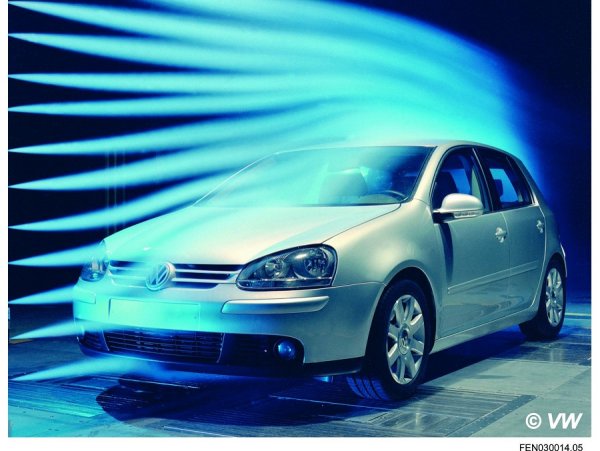


| Aerodynamic cars have been around for a long time |
It's hard to believe, but the car illustrated above, introduced in 1921, had a drag coefficient (cd-value) of about 0.28, which is, still today (2006) better than most modern cars. We're talking about the Tropfenwagen, (droplet car) made by Edmund Rumpler who was also an aircraft designer. The name of the car becomes clearer if one looks at it from above. It is rounded off in the front, with a tapering rear-end, almost like the shape of a falling drop of water. At that time, by the way, the main reason for this shape was, apart from the fuel economy, the low dust formation on the roads.
| Wind tunnel: measuring the strength of head-wind |
If a vehicle is moving through air, or air is blown into the wind-tunnel towards the vehicle, the front-end must first divide the airflow, push it aside, partially condense it, then bring it together again at the rear-end with as little turbulence as possible. Wind resistance develops in front through the build-up of air, and at the rear through vacuum, all together of course, also through the friction and turbulence of the air flowing past the vehicle.It's not all that easy to determine the wind resistance of a car without the measurements in the wind tunnel. A great many cars don't necessarily appear to have a favorable shape. Thus e.g., notchback vehicles, if they make it possible that the air-flow to the rear does not break down, often offer less resistance than vehicles with a 'fastback'. One can only really determine the cross-sectional area by projection of horizontal beams of light onto a vertical wall, but this has nothing to do with the drag coefficient, which has no dimensions and is dependent only on the shape of the car body. In addition, also the air-flow in the engine compartment and the underside of the vehicle are part of the aerodynamics. Nowadays, the underside, with the exception of the exhaust system, the wheels, and parts of the suspension, can be almost completely encased. The shorter the exhaust system (see McLaren SLR), the less turbulence there is on the underside casing.
| The uplift force as a danger for driving safety |
Apart from the drag coefficient, the uplift force is also important for the lift induced drag on the front- and on the rear axle. Which force lightens the vehicle unacceptably, and at which speed? The best known countermeasures are probably the front- or the rear spoilers. It is oftenmaintained that they would allow the car to go faster. The higher the generated downdraft force is, the more the airflow is deflected, then in fact, the aerodynamic wind resistance rises. There are, in the meantime, a number of more elegant possibilities to provide for downdraft force. Diffusers at the rear, under the vehicle floor are less noticeable, sloping of the vehicles horizontal surfaces, specially formed side plates and suitable roof endings are some.
| Aerodynamics improve bad weather vision |
Very little attention is paid to the influence of the air-flow on the visibility conditions, e.g., when it's raining. In this case, the water-flow is directed, by such inconspicious aids like rubber lips, small aluminium channels, synthetic channels and special styling so that the visibility is reduced as little as possible. Also the fouling of important areas can be kept within limits. A good example is the provision of horizontally terraced tail-lights.
| Design versus the physics of motion |
Why it has taken so long to reach the values of the car illustrated above? Because the greatest influence on the design comes from the customer, who apparently, finds it difficult to come to terms with particularly aerodynamic forms. Thus the overview can suffer and with it, the everyday suitability. Buyers are already protesting if the size of the openings for cool air are reduced because then, the frontend no longer has a typical car appearance.
Fortunately, there are still other possibilities for improvement. The gap measurements in the body-work and around the windows or headlights could be considered. In many other areas of vehicle technology, results can be better integrated into future development through measurements, than through the optimisation of the body-work, nonetheless, a whole series of measurements, repeated over and over again are necessary for detail improvement, and every time the complete experiment set-up must be carried out. Experience from preceding measurements can be used, only to a degree, for future developments. 09/10